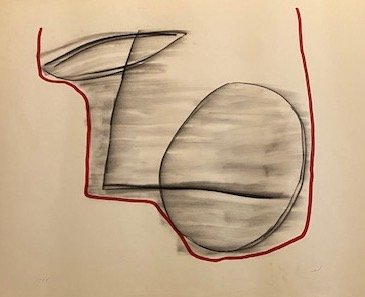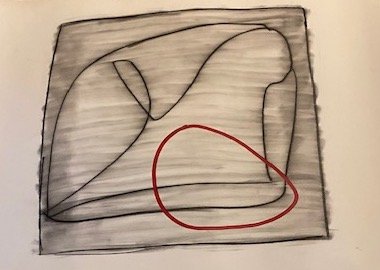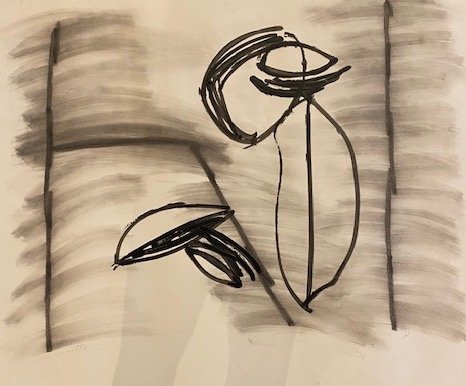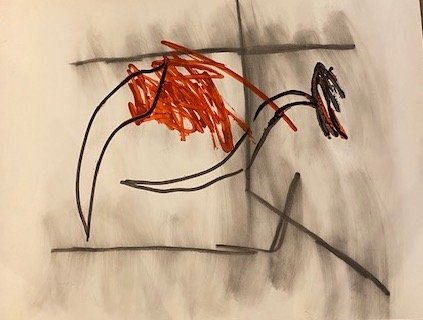Ellsworth Snyder
“To draw a line is to have an idea”; ellsworth Snyder is associated with the fluxus movement of the 1960’s, a period which emphasized happenings, performances, and anti-commercialism; “anti-art” art. Furthermore, he owned a considerable amount of ephemera and multiples from the movement. He was known as the leading authority on John Cage’s compositions, who wrote music for Snyder, and frequently sought both scholarly and pianist advice. snyder is well known for his musical performances and happenings of Cage’s work, and like his mentor, would deconstruct and reconstruct the piano in order to create different sounds from the instrument. Their experiments with contemporary music were a precursor to minimal/transcendental/electronic music, which strives to take the listener through a journey of time and/or landscapes. The experience of sensation, akin to the vibrational effect music has on one’s body, throughout snyder’s and Cage’s works on paper takes the viewer on a line of flight through their use of colour and stroke. In this sense, the audience’s participation and experience with the work is what lends each piece meaning.
The artist’s minimalist and expressive works exhibit a curiosity and awareness that allows his process to encourage the idea of chance, and remain open to choice through various media on paper such as acrylic paint, charcoal, oils, and pastels, to watercolors, as well as mixed media. His works are deceptively simple; they are based on the process of chance, and the I Ching idea of 3-3-3, which happens unpredictably either by human intervention or an exterior cause, are some sources of inspiration for Cage, ellsworth, and the Fluxus movement for creating art. “The tension between material and concept – the thing and the thought – was a main concern” for artists working within the movement. The interplay between negative and positive space; line and form; and the use of colour are evidence of snyder’s interpretation of the tension surrounding the representation of thought. As Snyder moved from concert pianist to painter, he felt he essentially moved from being a “middleman” to a creator. Artists, such as Cage and Snyder, preferred simplicity to complexity aesthetically, which is evident throughout snyder’s works on paper.
Although abstract work may seem incomprehensible initially and didactically, meaning can be found within the gesture and simplicity of his lines, and “the silence of the paper”. French philosopher Gilles Deleuze talks about lines of flight which represent a plane that is constantly moving, evolving, shifting, including jumps, voids, and immobilizations within its process of becoming. In this sense, desire can be attributed to the idea of chance, since it is desire that never needs interpreting to become, experimentation leads to creation. The use of plates, different media, the play of positive and negative space, as well as investigating the surface itself – these are elements of chance that snyder incorporated within his method of expression.
Further Reading:
Ellsworth Snyder, “artist statement”, 2001
“Remembering ellsworth snyder”, last modified 2011, http://www.codyarts.com/remembering-ellsworth-snyder.php.
“ellsworth snyder & John Cage: Inspiration and Collaboration”, last modified 2011, http://www.artnet.com/Galleries/Exhibitions.asp?grid=915&cid=124993.
“Dream (1948) by John Cage”, last modified Nov 16, 2007, http://www.youtube.com/watch?v=1UPIYnBFr10&feature=related.
“Silver Buckle Press”, accessed Oct 14, 2011, http://silverbucklepress.library.wisc.edu/projects/artists/snyder.html.
“Thing/Thought: Fluxus Editions 1962-1978”, MoMA
Snyder, interview with Thomas H. Garver, “Friends of The University of Wisconsin-Madison” Libraries, Nov & Dec 2001, Feb 2002
“ellsworth snyder & John Cage”
Gilles Deleuze, “Dialogues II”, (New York: University Press, 2007)

Ellsworth Snyder (American, 1931-2005)
Untitled, acrylic on paper, 30"x44"

Ellsworth Snyder, (American) 1931-2005
Untitled, Mixed media on paper, 35 x 44 inches

Ellsworth Snyder (American, 1931-2005)
Untitled, Mixed media on paper, 35 x 44 inches

Ellsworth Snyder, (American), 1931-2005
Untitled, Mixed media on paper, 35 x 44 inches

Ellsworth Snyder, (American), 1931-2005
Untitled, Work on Paper, 1982 35 x 44 inches

Ellsworth Snyder, (American), 1931-2005
Untitled, Work on Paper, 1982 35x 44inches

